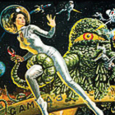Metro-Goldwyn-Mayer / Warner Home Video (1960-1968 / 2010), two single discs, Atlantis: 90 mins, 1.78:1; Power: 108 mins, 2.35:1, both Dolby Mono, Not Rated, $19.95 each (sold separately)
The Movies:
Hollywood has, of course, produced scores of directors who became big names in their own right, often selling a film by having their moniker on the poster in the same size as the leading man or lady just as well as the stars of a picture. But for all the Victor Flemings and Cecil B. DeMilles from Tinsel Town, if there was ever a producer/director from the classic era of Hollywood that could be counted alongside later “superstar” directors as Steven Spielberg and George Lucas in the same breath, it would have to be Hungarian-born animator-turned-visual effects movie creator George Pal, who arguably made what are now called “event” pictures years before the word “franchise” was ever applied to a film property.
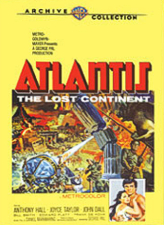 Destination Moon, When Worlds Collide, The Time Machine and the original War Of The Worlds…if made today, these films would easily be the kinds of big, Fourth of July spectacles that would blow any other competitors out of the multiplexes, combining solid screen storytelling with unique and groundbreaking visual effects touches. Pal had arrived in the US with help from his friend Walter Lantz, after moving from Hungary to run his own studio in Berlin, developing his patented stop-motion Puppetoon system. With the threat of war in Europe, Pal escaped to America, producing the Puppetoon series that powered his creativity for creating “trick films”.
Destination Moon, When Worlds Collide, The Time Machine and the original War Of The Worlds…if made today, these films would easily be the kinds of big, Fourth of July spectacles that would blow any other competitors out of the multiplexes, combining solid screen storytelling with unique and groundbreaking visual effects touches. Pal had arrived in the US with help from his friend Walter Lantz, after moving from Hungary to run his own studio in Berlin, developing his patented stop-motion Puppetoon system. With the threat of war in Europe, Pal escaped to America, producing the Puppetoon series that powered his creativity for creating “trick films”.
The Puppetoons popularity and critical success saw Pal nominated for seven consecutive years in the Best Animated Short category at the Oscars, between 1942 and 1948, and a step to features was natural. The Great Rupert, a very sweet Christmas story that featured a stop-motion squirrel counterfoil for star Jimmy Durante, came in 1950, as did Destination Moon, an early space exploration picture that, while cheesy looking to our eyes today, actually got more right than it did wrong and, along with Things To Come was one of only a few serious sci-fi films to be taken seriously before 2001: A Space Odyssey.
Pal quickly became known as a purveyor of big-budget science fiction with the follow ups of When Worlds Collide and War Of The Worlds, which was directed by frequent collaborator Byron Haskin, but their next film together, Conquest of Space, was a visual effects tour de force that buckled under the demands of its weighty story. Pal’s career took a hit, but he continued to produce or direct a number of hugely entertaining films, including the fairytales tom thumb and The Wonderful World Of The Brothers Grimm, which featured Puppetoon story sequences.
In later years, as cinema moved away from spectacle towards more introverted, serious fare, Pal’s budgets became smaller though his imagination remained full of big ideas. Newly released to the Warner Archive Collection are a pair of films that finds the director in the midst of his huge success and towards the end of it: one of which is pure popcorn nonsense, but none the less entertaining for it, and the other a vastly underrated supernatural thriller that may show some restraint in the overblown visuals but only makes it a more compelling and intriguing outing that really gets in your head…
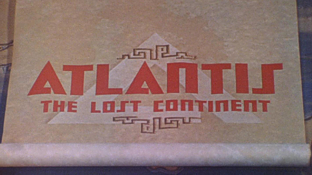 Atlantis: The Lost Continent (1961)
Atlantis: The Lost Continent (1961)
Finding Pal at an interesting juncture in his filmography, Atlantis came right between the Oscar-winning (for Best Special Effects) and commercial success of tom thumb and The Time Machine (1958 and 1960 respectively) and The Wonderful World Of The Brothers Grimm (1962), so it’s unsurprising to find the director in a whimsical place of fantasy, half sci-fi inspired and half fairytale. The likes of Jason And The Argonauts and the films featuring Ray Harryhausen’s animation effects were also hugely popular at the time, and Atlantis: The Lost Continent clearly takes its lead from those toga classics.
It follows the adventures of a headstrong young Greek fisherman Demetrios who rescues a damsel lost at sea. She reveals herself to be the daughter of the King of a fabled land, suggesting that, if the fisherman returns her safely, he would be rewarded beyond his wildest dreams. He, however, is more interested in her and the thought of discovering Atlantis, but instead of a benign civilization of friendly Atlanteans, Demetrios finds himself slaved amongst a war-hungry realm of barbarians and ungodly experimentation where the unfortunate are converted into beasts of burden. Undergoing the Ordeal of Fire and Ice to win back his freedom, Demetrios becomes an ally to the Princess and attempts to shake her father from the influence of his advisor, before the inevitable impending doom from a volcano threatens to destroy Atlantis forever!
 Yes, it’s one of those movies, where everything is thrown in, in an attempt to hold the interest. And on the whole it does, though that might just be because it was calling to the big kid in me, and surprised me with some of its scenes as much as it made me grin. As is expected for a Pal production, the visuals are spectacular, especially for this age, with a really nice sea-creature submarine vessel design well designed and implemented, and better, I thought, in scale to Disney’s Nautilus.
Yes, it’s one of those movies, where everything is thrown in, in an attempt to hold the interest. And on the whole it does, though that might just be because it was calling to the big kid in me, and surprised me with some of its scenes as much as it made me grin. As is expected for a Pal production, the visuals are spectacular, especially for this age, with a really nice sea-creature submarine vessel design well designed and implemented, and better, I thought, in scale to Disney’s Nautilus.
The later effects, notably evil Zaren’s (John Dall, who naturally gets the best lines) crystal death-ray, aren’t quite as fake looking as something with that name would imply, actually calling to mind the Death Star, and among the Saturday matinee adventuring, there’s a real attempt to inject some thought into the script by way of political and religious themes that examine how a technologically aware society can bend that power to become corrupt and dangerous to more than just those around them.
Pal’s intentions were to push Atlantis more in these directions, to create an epic fantasy that would be taken as seriously as it entertained. However, the budget was a concern, a writers strike prevented a further script polish before the cameras had to roll, and he was forced to cut corners in several areas, not least in the unfortunate event of having to licence footage from other sword and sandal epics – Quo Vadis chiefly among them – to depict some of the more major crowd scenes (Pal also copied himself: his later film 7 Faces Of Dr Lao reused some of the destruction footage), although to be fair a lot of the films featuring Greek and Roman myths also pulled this trick. The costumes may also be the familiar colorful robes we remember from other such fare, and Demetrios’ himself, Italian singer Sal Ponti playing as Anthony Hall, might be as wooden as they come, though no more than Sam Worthington in the Clash Of The Titans update.
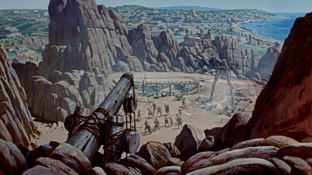 Comparisons to Disney’s modern Atlantis story, The Lost Empire, are pretty redundant for the difference in approach, both from a plot point and in the generations between both films’ release. Nevertheless there are still some similarities: the hero does indeed fall for the Atlantean Princess (Joyce Taylor, a real Hollywood starlet who’s make-up is never washed away despite the ample buckets of water thrown at her), while her father is also a frail King.
Comparisons to Disney’s modern Atlantis story, The Lost Empire, are pretty redundant for the difference in approach, both from a plot point and in the generations between both films’ release. Nevertheless there are still some similarities: the hero does indeed fall for the Atlantean Princess (Joyce Taylor, a real Hollywood starlet who’s make-up is never washed away despite the ample buckets of water thrown at her), while her father is also a frail King.
It’s more fun to pick out some other references: Daniel (Invasion Of The Body Snatchers) Mainwaring’s screenplay lifts ideas freely from any number of other gladiator pictures of the time, Russell Garcia’s thumping score borrows whole cues from his memorable music for The Time Machine, and the production design further draws from that film’s Wells/Verne sensibilities and Pal’s own sci-fi effects (Dall’s fate as his death ray spirals out of control is a shot that could have come direct from War Of The Worlds).
Long a film I’ve been unable to see (I missed out on a double-feature set of Atlantis and The Power on LaserDisc, much to my chagrin for many years!), this was one of the very few films of Pal’s that I had not seen or did not have in my collection. But now I’m very glad to, since it easily stands up alongside, and sometimes beats, Harryhausen’s films in its tone, and the visual effects shots really stretch the budget to bring the epic nature Pal was looking for, with exceptional miniature work that depicts the world of Atlantis very convincingly. Yes, it may be argued that this isn’t Pal’s greatest hour but, whatever the shortcomings, there’s a great spirit of fun running through the film, and as with any mythical adventure, belief is merely there to be suspended!
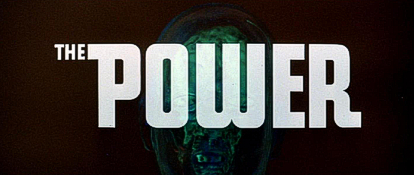 The Power (1968)
The Power (1968)
As a Pal fan, I’ve naturally attempted to catch everything he had his hand in, and it was late one night when I caught a pan-and-scan version of The Power on television. I had recently read director Byron Haskin’s book on working with Pal, and The Power was a project that received an interesting treatment, with the director not totally happy with the end result or the way the studio sold it.
As with Haskin and Pal’s previously heavy sci-fi collaboration, The War Of The Worlds, Haskin believed that the film would have been a major smash had it been marketed as an event movie, in the way that Jaws and Star Wars would be in later years.
While that trick might have worked for Worlds, The Power is altogether a much more layered film, with some scenes that bend the mind in the direction they go off in. It’s actually hard to discuss the film without giving too much away, and though there’s a bit of a twist towards the end that today’s audiences will probably see coming right from the start, I’d still hate to ruin what might be quite a thrilling surprise. You might say The Power was the Inception of its day, a film that plays mind games with both the characters on screen and with the audience watching.
George Hamilton, before he became something of a caricature of bland Hollywood stereotypes, plays extremely well here in a serious role as a government agent participating in scientific experiments with telekinesis, which begins to turn awry when one of their number exceeds any known boundaries of such superhuman power and begins to use it to influence others’ minds for their own benefit. Following the death of a suspicious professor, Hamilton begins to delve deeper into the mystery, but finds the phantom menace following him at every turn, becoming a growing threat until he is forced to go on the run with his only trusted colleague (Susanne Pleshette), and they attempt to track down the man identified in their only lead: the mysterious Adam Hart…
 Ultimately a big break not only from Pal’s usual light-hearted fantasy, fairytale or mythical fare but from most of contemporary Hollywood of the time, The Power really is a one-of-a-kind movie, which is why it may either be underrated or loved by whoever you speak to. I can only say that, having caught it as a Pal fan and not knowing what to expect, I was captivated by its unique approach…a supernatural thriller with some real “what the…?” moments that kept me gripped throughout.
Ultimately a big break not only from Pal’s usual light-hearted fantasy, fairytale or mythical fare but from most of contemporary Hollywood of the time, The Power really is a one-of-a-kind movie, which is why it may either be underrated or loved by whoever you speak to. I can only say that, having caught it as a Pal fan and not knowing what to expect, I was captivated by its unique approach…a supernatural thriller with some real “what the…?” moments that kept me gripped throughout.
Yes, there are some moments where audience imagination may come into play, and an extended party scene that feels out of place and may have been an attempt to appeal to 1960s crowds, but even these can’t really be honest strikes against a film that attempts so much of a new thing.
In many ways, The Power predates later such eerie offerings as The Omen, Carrie, Scanners and, especially, the Kirk Douglas-starrer The Fury, which for me this film easily beats hands down, even if those later films attempted to shock with more gore as opposed to The Power’s entertaining thrills. There are back-references, too: the film is actually a remake of a 1956 Studio One episode, itself a version of Frank M. Robinson’s then-recent novel, though Pal and Haskin’s film expand things for the screen to include an oppressive hall-of-mirrors, a desert-set aerial attack that’s reminiscent of Cary Grant’s brush with the dust cropping plane in North By Northwest, and a psychologically turbulent climax that features some quite disturbing effects (including a decomposing head long before Raiders Of The Lost Ark).
The casting also includes a number of recognisable faces, including Pleshette, going for another serious role after a number of Disney comedies, who by all accounts didn’t understand the material and had continuous fallings out with director Haskin. Not that you’d know it: she’s quite excellent throughout in a largely thankless part, though it is said the rather abrupt ending was due in part on her insistence of being given more to do. Of great value is Nehemiah Persoff (later to be Fievel’s Grandfather in An American Tail) as another of the scientists, and The Day The Earth Stood Still’s Klaatu himself, Michael Rennie, as the government official who initiates the search for Hart, the man responsible for a number of recent deaths.
 These feature a quite exhilarating “death by centrifuge” moment early on, and an ominously manipulated Walk/Don’t Run sign programmed to inflict maximum paranoia, while another touches recognisable as Pal moments number animated toy soldiers warning of impending danger by firing real gunpowder, and adding class to the soundtrack is the legendary Miklós Rózsa, providing his last score for an MGM film.
These feature a quite exhilarating “death by centrifuge” moment early on, and an ominously manipulated Walk/Don’t Run sign programmed to inflict maximum paranoia, while another touches recognisable as Pal moments number animated toy soldiers warning of impending danger by firing real gunpowder, and adding class to the soundtrack is the legendary Miklós Rózsa, providing his last score for an MGM film.
There’s a Hungarian undercurrent running through the film: Pal as producer, obviously, enlisted co-countryman Rózsa to come out of retirement to score the film, playing up the connection with the Adam Hart character, himself Hungarian, and The Power’s great heartbeat motif is combined with a main theme played on the Hungarian cimbalom instrument, which Pal loved so much he uses a visual of it in the opening credits.
For whatever reasons, The Power didn’t find its audience back in the late 1960s, but became something of a hidden cult hit among fans, amongst who actually having seen the film marked something of a badge of honor. As Pal’s penultimate film, coming just before the belated Doc Savage, it often gets overlooked alongside Atlantis: The Lost Continent. While that film can’t rightfully be expected to stand alongside Pal’s best work (Destination Moon, The Time Machine, War Of The Worlds), The Power certainly can, as a compelling thriller that expertly combines elements of film noir and fantasy. Remade nowadays it would literally be quite frightening, even if audiences back in the day weren’t ready to experience such a strange, and often intense, adventure. Forgive the one or two sometimes weaker than ideal workarounds, and The Power certainly has it.
The Discs:
Originally marked as one of Warner Archive’s “Remastered Edition” titles, The Power turns up on disc as a more regular entry in the line, which is a bit of a shame for a well-regarded fan favorite and a film that, even last year, was earmarked for the proper mainstream commercial release treatment. It’s a worry that some of these films, which may not sell in the millions, are being diverted to the WB Archive Collection, when fans would still be more satisfied with discs that are more easily purchased from other stockists, and often for far less than WB’s customary $20 a pop.
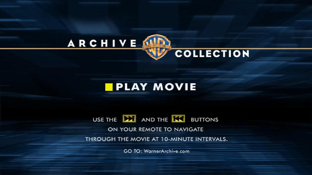 That’s quite a bit to pay for a vanilla disc that’s only been mastered from the current best available print transfer, but as I’ve said in the past it’s also the only way to own official releases of some often unseen and obscure titles. Warners do need to offer more incentive, however, such as pairing these two titles off into either a better value double feature set, as per a previous LaserDisc set, or a better deal on ordering both at the same time ($30 for both?). Even better would be even the most basic of extras: trailers have often popped up on other WBAC titles and here they’re a most disappointing omission.
That’s quite a bit to pay for a vanilla disc that’s only been mastered from the current best available print transfer, but as I’ve said in the past it’s also the only way to own official releases of some often unseen and obscure titles. Warners do need to offer more incentive, however, such as pairing these two titles off into either a better value double feature set, as per a previous LaserDisc set, or a better deal on ordering both at the same time ($30 for both?). Even better would be even the most basic of extras: trailers have often popped up on other WBAC titles and here they’re a most disappointing omission.
Bonus footage does exist: Image Entertainment’s quite wonderful trio of Pal discs (The Puppetoon Movie, The Great Rupert, The Fantasy Film Worlds Of George Pal), collected in the exceptional and very highly recommended George Pal’s Flights Of Fantasy boxed set collection, featured a wealth of supplemental material that touched on these titles. Granted, permission to licence that footage may have been a stumbling block, but The Power especially was a well promoted picture and surely something could have been added.
The lack of value sadly stretches to The Power’s quite frankly poor image transfer, a real disappointment covered in speckles and print artefacts, gateweave and a recurring light scratch (especially in the opening reel as seen below) which Warners should really be quite embarrassed about. Opening up the frame is otherwise a revelation in its Panavision widescreen format, only making it harder to see how this visionary movie didn’t find more of an audience at the time of its release. There’s some unexpectedly serious stuff going on in the film, and the 2.35:1 framing only adds to the paranoia and sense of isolation throughout, while also adding a superior production value to the visuals, but ultimately the image treatment is a real shame for a film that deserves so so much more.
 By comparison, Atlantis, despite showing a few visible print defects of its own (mostly on the more obvious optical effects, which suggests they’re inherent in the original negatives), looks unexpectedly sharp in its intended 1.78:1 aspect, most likely either opened up from 1.85, or just about making a fit from a 1.75 VistaVision type projection ratio. Color is vibrant, though one may notice a little bleed or smudging here and there, depending on the scene and its lighting.
By comparison, Atlantis, despite showing a few visible print defects of its own (mostly on the more obvious optical effects, which suggests they’re inherent in the original negatives), looks unexpectedly sharp in its intended 1.78:1 aspect, most likely either opened up from 1.85, or just about making a fit from a 1.75 VistaVision type projection ratio. Color is vibrant, though one may notice a little bleed or smudging here and there, depending on the scene and its lighting.
On the audio side of things, both films are presented in Mono, which was the generally standard sound format of the time, though some prestige showcase presentations may have featured stereo tracks: certainly Garcia and Rózsa’s music scores were recorded as such. Again The Power comes off worse, with noticeable background noise present throughout that sadly seems to date the film more and is only drowned out when the music gets bombastically excited. Atlantis doesn’t fare nearly as bad, with a strong soundtrack that balances the music against perfectly audible dialogue, but it’s another disappointment over these two releases that the better film gets the poorer treatment.
As usual for the WBAC, the cover art continues to display a distinctive look, but like most of the new releases now, breaks away from the previous uniformed look to look more like regular DVD releases, with nice use of the original poster art including Atlantis’ high detailed panting and The Power’s evocative – and quite scary looking! – collage of melded faces and abstract imagery, suggesting the mind-playing games to be found in the film. Each film’s respective logos are nicely printed onto the discs themselves, raising the overall appearance of the DVD-R platters, a format that some continue to dislike but that, apart from two minor instances of picture break-up on The Power, I can’t say I’ve had any real trouble with.
Cinematic Classic or Faded Print?
 One of the more derided and one of the more underrated of George Pal’s titles are to be found within the cases of these two new offerings from the Warner Archive Collection. Both films are valid additions to any library, especially those that have followed and collected Pal’s work. The man, at the end of the day, had a pretty decent track record, and there’s not really a true dud movie in his run of what would now be called high concept entertainments.
One of the more derided and one of the more underrated of George Pal’s titles are to be found within the cases of these two new offerings from the Warner Archive Collection. Both films are valid additions to any library, especially those that have followed and collected Pal’s work. The man, at the end of the day, had a pretty decent track record, and there’s not really a true dud movie in his run of what would now be called high concept entertainments.
These films will play to different audiences, to be sure, with Atlantis a great family filler for turning a wet afternoon into an exciting adventure, and The Power perhaps something more occasionally intense for thrill-seeking adults to watch while the kids are tucked up in bed.
However, and despite the standard Archive Collection treatment, it’s a major disappointment to report that neither come with even the slightest of extras, and in particular to have to warn of The Power’s unexpectedly poor showing on its disc. Hopefully my words above on the movie’s merits may lead you to overcome those shortcomings, since the film really is one to see, and once it’s underway I became lost in its twists and the print cleaned itself up a bit.
I can’t say how pleased I am to be able to add official versions to my Pal collection, and certainly recommend both titles – The Power especially – as strong examples of their respective fantasy and supernatural genres, even if I can’t shake the feeling that Warners have simply dumped these titles on disc after making fans wait for, and expect, much better editions.
and many others directly from the online store at WB ARCHIVE COLLECTION




